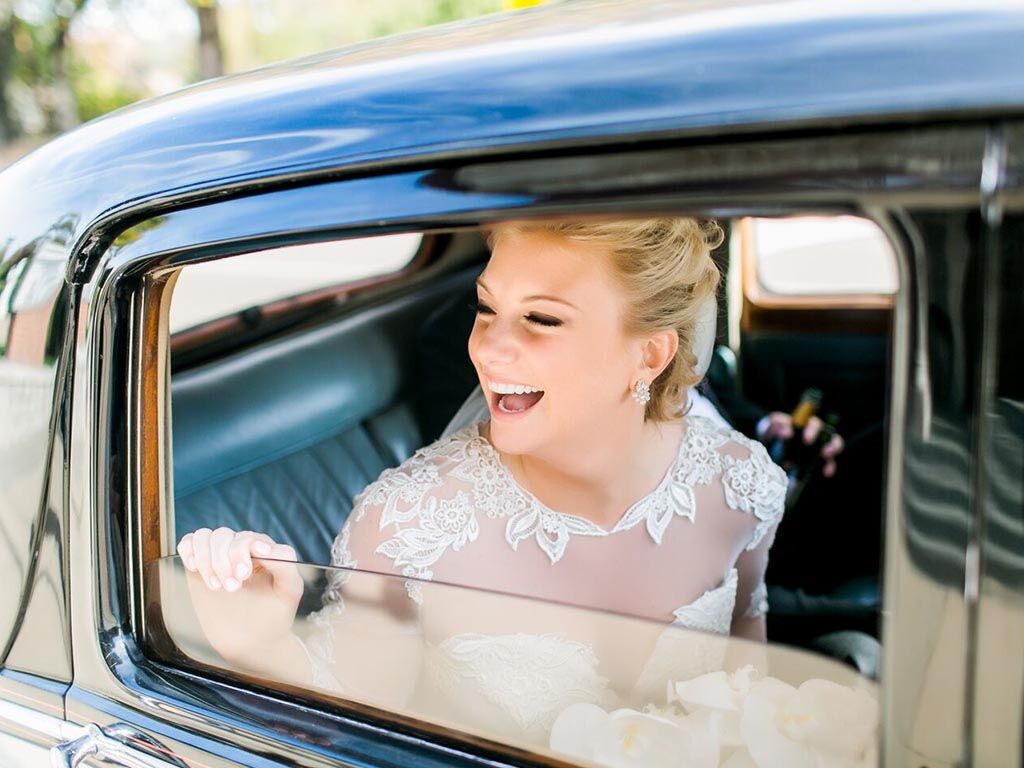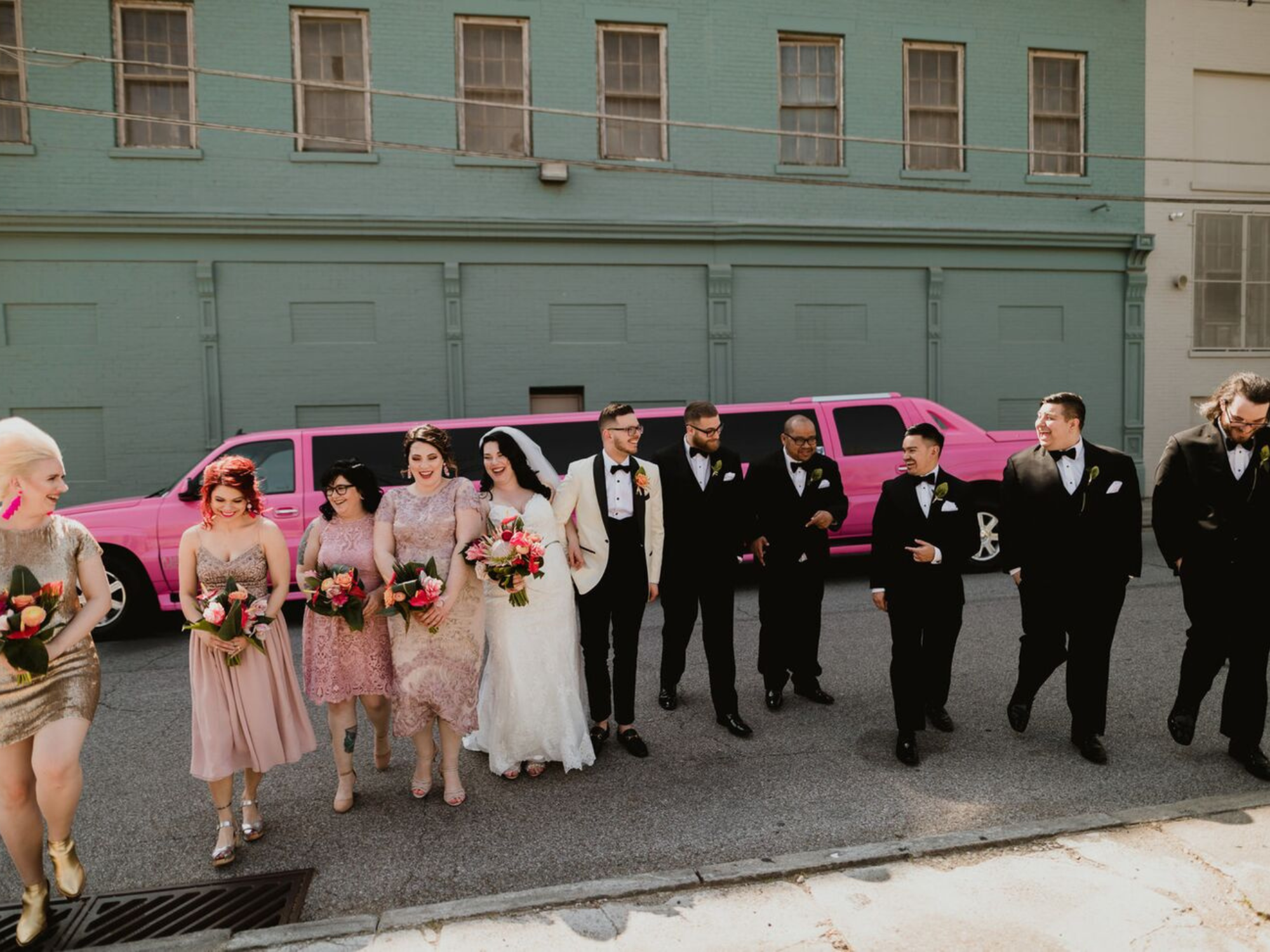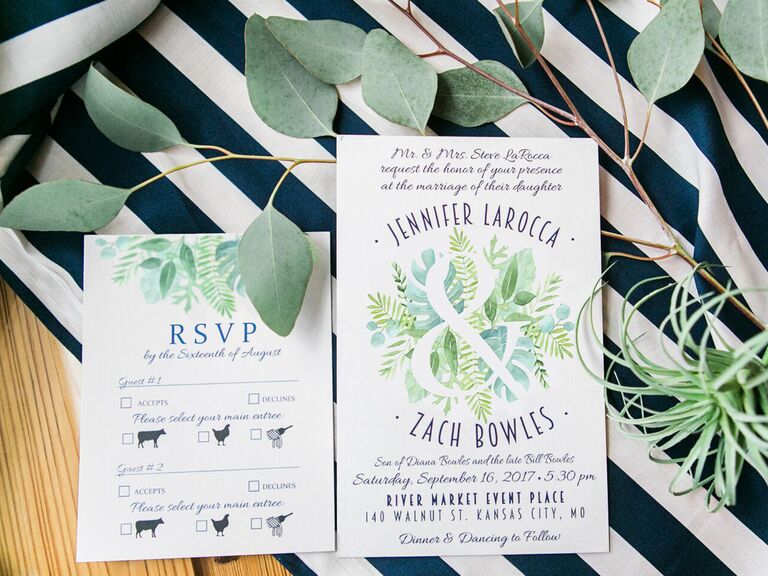Do You Need to Include a Meal Selection on Your RSVP Card? Here's What We Think
A wedding invitation's response card must answer one essential question: Is the guest attending the big day or not? However, nowadays, couples are using their wedding RSVP cards to gather other important details from their guests. One of these is a guest's meal choice—many couples are now adding a space for guests to write or check off which entrée they'd like during the reception. Knowing your guests' meal choices prior to your wedding day will help you (and your vendors) immensely—especially if you're having a seated dinner. Your caterer (or reception space, if that's who's catering your wedding) will need the numbers to know how much of each dish to prepare. In fact, they'll probably request the information in advance.
Oddly enough, incorporating a meal selection option on your reply card has previously gotten a bad rap. It may not seem like the most glamorous or aesthetically pleasing thing to add to your RSVP cards, but we'd say it's pretty necessary and no longer considered "tacky" at all—and there are tons of ways to get creative with it. Here's all you need to know about creating an RSVP card with a meal choice field.
How do you include menu selections on your RSVP cards?
If you're creating printed wedding invitations, you can add a food choice section to the response card itself, or on a separate enclosure card included in your invitation suite. Not only is it important to know how many of each entrée your party will need, but you should also create a system where you know which wedding guest wants each dish. Make sure you provide enough space for more than one guest to write their initials next to each entrée selection. Here's an RSVP card wording example:
Please initial a meal choice for each guest:
Chicken __ Fish __ Beef __ Vegetarian __
Or you could create a separate line for each invited guest, so that the entrée choice is even clearer. Each guest would write their name in the space provided, check a box as to whether or not they can attend the wedding, and then circle a picture of a chicken, cow, fish or vegetable (or other meal option) depending on their meal choice. Using a picture to represent each menu selection can be a fun twist on the traditional and provide a nice visual cue.
If you've finalized your wedding menu before you send out your invites, you might include a little more detail on each menu choice. It's not necessary to write out a full menu, but saying "filet mignon" rather than beef or "mahi mahi" instead of fish can help your guests more easily choose their entrée.
And if you're using online RSVP as part of your wedding website, create additional fields to request each guest's meal choice. An online RSVP makes it even easier to collect everyone's food order, and it saves paper, too!
Pros and Cons of RSVP Cards With Meal Choice
Now here's the big question: Should you actually request your guests' meal choice on their RSVP card? You'll only need to make this decision if you're having a sit-down dinner with menu options—if you're serving everyone the same entrée, you're all set! But if your guests will have a choice, you'll have to work with your caterer to decide if having everyone's order in advance is a good idea. Here are the pros and cons of RSVP cards with meal choice:
Pro: There will be less food waste.
If you don't gather everyone's menu choice in advance, your caterer will need to bring enough food so that if everyone orders the beef, for example, there will be enough—and that means a lot of uneaten food will go to waste at the end of the event. By requesting your guests' desired entrée on the wedding invitation RSVP card and sharing that information with your food pros, they can bring the proper amount of food without much additional waste.
Con: Guests might change their minds.
It's pretty hard to predict what you'll want to eat over a month from now, but that's exactly what you're asking your guests to do. On the big day, your guests may decide they'd prefer the chicken over the beef, or they may see that the fish entrée looks really tasty and opt for that instead. Your caterer can bring a few extra of each entrée to accommodate these last-minute changes.



Pro: Most caterers prefer this route.
About a week before your wedding, you'll provide your caterer with the final headcount—and possibly everyone's menu choice, too. Getting everyone's entrée choice on the wedding response card can make a caterer's job easier. Not only will they know how much food to bring, having each guest's meal selection will save time—waitstaff won't need to go table to table to take everyone's dinner order.
Con: You'll likely need place cards.
While most weddings offer escort cards or a seating chart to provide table assignments, place cards, which assign a specific seat to each guest, are optional. However, if you're requesting meal choices in advance, you'll need some way for your caterer to know which guest receives which entrée—and place cards are the most straightforward way to do that. You can include a small icon of a chicken, fish, etc. on each place card so your catering team can quickly and easily determine which dish goes where.
Pro or Con: It's not the traditional option.
In the past, having guests order their entrée at the reception was seen as a more formal and traditional choice—and including a meal choice on the RSVP card was seen as "tacky". With more modern weddings, requesting guests' meal choice on wedding stationery is increasingly common. Sure, some of your guests may turn their noses up at this "nontraditional" strategy, but your wedding doesn't have to be traditional to be amazing.
Should you ask guests to share dietary restrictions on their RSVP card as well?
Even if you're having a buffet or family-style meal, you'll be happy to be aware of any food allergies or dietary restrictions in advance, too—so we highly recommend asking about this on your RSVP card. You'll have to adjust your RSVP card template accordingly and include enough space for guests to write down any issues, but having this information in advance will help you and caterer ensure that everyone will have food to enjoy on the big day. Here's some sample wording:
Please advise of any food allergies: __________________________
If there are guests will serious allergies, you might consider going over the menu card with them before the wedding so they're aware of what they can and can't eat.
What are other catering serving style options?
During the wedding planning process, you'll need to decide which catering serving style you'll feature at your wedding. A sit-down dinner means your guests will be served an individual entrée. You could provide several menu options (which may or may not mean collecting everyone's orders on the RSVP card), or give every guest the same entrée. If you go the latter route, your caterer may create what's called a duet or duo plate, which offers two proteins to provide guests some variety.
A buffet is another popular catering style, where guests typically serve themselves (though some buffets may have waitstaff doing the serving). This is an affordable option that allows guests to choose what and how much they'll eat.
A family-style meal is growing in popularity. With this serving style, guests are given large plates of food that they pass around their tables and serve themselves. Like the buffet, guests can choose their meal and the amount, but they won't have to wait in line as they would for a buffet.
There are several other serving styles, including cocktail-style, food stations and even food trucks. Work with your caterer to determine which food service is best for your wedding day.





















